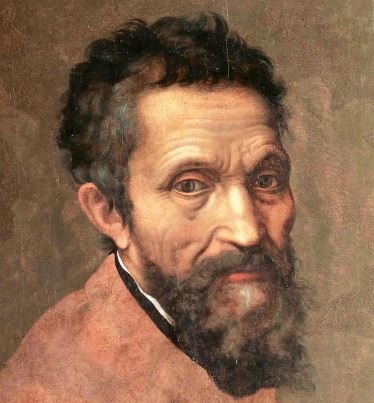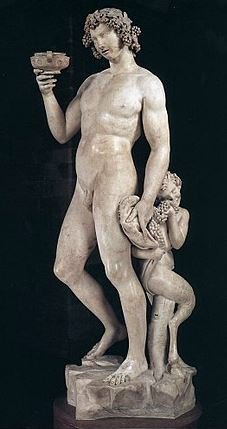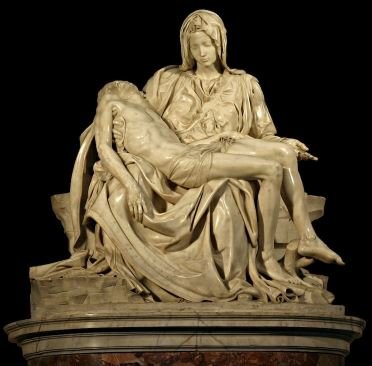Michelangelo – Life and Monumental Contributions during the Renaissance Era

Life and Contributions of Michelangelo | ‘Portrait of Michelangelo’ by Daniele da Volterra, ca. 1544
Michelangelo was an immensely skilled sculptor, painter, poet and architect whose works epitomized the High Renaissance period in Italy. Virtually in every genre of art, the talented Michelangelo – an artist who started as an apprentice painter – left an indelible and unsurpassable mark on the world. Allied to the Medici, this Renaissance genius’ works include the David, the Pietà, the Bacchus and the paintings on the ceiling of the Sistine Chapel.
Early life and Education
In Caprese, Italy, on March 6, 1475, Michelangelo was born to parents – Leonardo di Buonarrota Simoni and Francesca Neri. His full name was Michelangelo di Lodovico Buonarroti Simoni. His parents were from Florence and their roots could be traced to Florence’s nobility of renowned bankers.
Due to a slump in the fortunes of the family, Michelangelo’s father Leonardo had to take up a government official position (a magistrate of some sort) in the town of Caprese. This happened around the time of Michelangelo’s birth.

Michelangelo’s Quote from his early life
A few months into Michelangelo’s birth, the family returned to Florence. It was also around this time that his mother Francesca Neri took ill. When he was about 6 years old, his mother passed away. In the absence of any motherly figure, Michelangelo took comfort among a family of stonecutters. It was there that he got his first-hand exposure to stonecutting and sculpting.

Domenico Ghirlandaio – one of Michelangelo’s first tutors
Around the age of 13, Michelangelo started his apprenticeship under the guidance of a fresco painter and renowned tutor of arts, Domenico Ghirlandaio. He got to know Ghirlandaio through Francesco Granacci, also a student of Ghirlandaio. During his time with Ghirlandaio, he was exposed to crucial fresco, portraiture, figure drawing techniques, and panel painting methods.
Post Apprenticeship and Interactions with the Medici

Lorenzo de Medici – an influential patron of Michelangelo’s artworks | Portrait by Agnolo Bronzino at the Uffizi, Florence
Michelangelo was meant to spend three years with Ghirlandaio; however, Michelangelo left a year into his apprenticeship. He believed that there was nothing more that he could learn at Ghirlandaio’s workshop. Another account of the story states that it was actually Ghirlandaio who advised the young Michelangelo to move into a more renowned workshop in Florence.
Young and budding, Michelangelo heeded the advice of his tutor and followed his passion for art by forming alliances and working with Florence’s very wealthy and ruling family, the Medici. It is known that Lorenzo de’ Medici (commonly called Lorenzo, the Magnificent) and Michelangelo built a strong bond, underpinned by their mutual love for the arts and diverse knowledge in general.
Between 1489 and 1492, Michelangelo committed himself to honing his talents in classical sculpture. Due to his connections to such a powerful group as the Medici, Michelangelo had the privilege of studying under and interacting with several esteemed sculptors, learned art professionals and philosophers in the gardens of the Medici family, Florence (also known as the Humanist Academy of Florence). Most notable of these tutors was the classical sculptor Bertoldo di Giovanni.
Early Career and Exploits

Michelangelo’s early artworks — from left to right: Michelangelo’s Madonna della Scala (Madonna of Stairs, 1492) and Battle of the Centaurs (1491/1492)
Michelangelo’s career took off at an early age. By age 16, he had produced two very amazing relief sculptures – Battle of the Centaurs (1491/1492) and Madonna Seated on a Step (1490 – 1492).
All throughout Michelangelo’s time, Florence was famed to have some of the best painters, sculptors, and poets. However, there was also immense competition among those artists. With this competition came better artistic works from the artists.
And if one was as good as Michelangelo, the artist could easily find himself a project to commission. However, the commissions were not as big and profitable for some artists. These phenomena forced many famous artists to briefly leave Florence. People like Leonardo da Vinci and his tutor, Andrea del Verrochio all left Florence in pursuit of a place that offered them better commission and projects. So did Michelangelo. He made his way to Bologna when the Medici lost control of Florence. The new rulers were a bit too anti-Renaissance for Michelangelo’s liking.
Time in Bologna
In Bologna, Michelangelo secured a commission to finish the incomplete work of a famous sculptor who had died. The project was the tomb of St. Dominic. Quite different from the original sculptor’s approach, Michelangelo seemed to have breathed life into the marble figures of the tomb. Upon completion, the work oozed out high levels of realism as compared to the fanciful approach of the sculptor that started the work earlier.
Staying in the company of Gianfranco Aldrovandi, Michelangelo had the chance to advance his knowledge in poetry, painting, and sculpting. He took a shine to classical antiquity styles while in Bologna. His stay in Bologna was also a bit elongated due to political strife that briefly engulfed Florence. Some famous members of the Medici family were exiled out of Florence around 1494.
Once the tensions in Florence died down a bit, Michelangelo returned to Florence in 1495. Back in Florence, Michelangelo struggled to get any commissions from the Florence government, who was at that time under Savonarola.
Controversy over Michelangelo’s Cupid sculpture
Around the mid-1490s, Michelangelo got himself into hot waters after his Cupid sculpture (now lost) was allegedly (perhaps deceitfully as well) aged to pass off as an antique. Historians have long maintained that Michelangelo did this with no malice intended. It was simply part of an art style that he tried to communicate.
On the contrary, another account of the story states that Michelangelo connived with the art dealer Lorenzo di Pierfrancesco de’ Medici to carry out this deceitful act. He buried the marble Cupid, hoping to throw the dust into the eyes of prospective buyers and then make it look like it came from antiquities. With such cunning techniques, the sculpture fetched him a very high price from a Catholic cardinal, Raffaele Riario of San Giorgio.
Regardless of this controversy, Cardinal Riario was still taken aback by the sheer beauty of the “Cupid” sculpture. He allowed Michelangelo to keep the money even though he knew the sculpture was not an antique. Rather than go mad over the forgery, the cardinal went on to send an invitation to Michelangelo in the mid-1490s. Over in Rome, Michelangelo’s career effectively got a sharp boost. This was primarily as a result of the stupendous works that Michelangelo commissioned for the cardinal.
Important Works and Contributions to Arts
The following are some key examples of Michelangelo’s famous sculptures and paintings and life works:
‘Bacchus’ (1496-1497)

Michelangelo’s sculpture Bacchus, a Roman god of wine
While in the services of Cardinal Raffaele Riario, around 1496, Michelangelo sculpted a life-size statue of Bacchus, the Roman god of wine. Unfortunately, the cardinal did not take any liking to the statue due to its pagan origins; hence, he rejected it. The statue Bacchus ended up being purchased by Jacopo Galli – a very influential banker. Galli placed the statue in his garden. After about half a century, in the 1570s, the Bacchus found a new home in Florence.
Michelangelo’s ‘Pietà’

“The Pietà” by Michelangelo (1498-1499)
In the year 1496/1497, the French ambassador to the pope – Cardinal Jean Bilheres de Lagraulas – tasked Michelangelo to sculpt the Pietà. The sculpture depicted the grieving Virgin Mary carrying the corpse of Jesus Christ across her lap.
Astonishingly, Michelangelo was only 25 at the time that the Pietà was commissioned. The Pietà statue, carved from a carrara marble, took him about a year to complete.

Renowned artist, writer, and historian Giorgio Vasari’s comment
The statue Pietà, which was human sized and about 6 feet wide, was originally placed in the cardinal’s tomb. Today, however, it resides in at St. Peter’s Basilica, Vatican City. Up to this day, the Pietà continues to elicit immense veneration from around the world. It is truly one of Michelangelo’s greatest works.
‘David’ (1501 – 1503)

Michelangelo’s David
With the tides shifting against the anti-Renaissance ruler of Florence – Girolamo Savonarola – Michelangelo decided to go back to Florence in 1499. He went straight into working on a statue for the consuls of the Guild of Wool Merchant (Arte della Lana). The guild wanted a statue of David in order to symbolize the wind of freedom that was blowing over Florence.
Michelangelo’s statue of ‘David’ needed about 3 years to complete, from 1501 to 1504. Originally, the marble used in sculpting Michelangelo’s ‘David‘ was used by two sculptors. However, they (Agostino di Duccio) abandoned the project and the marble. Michelangelo took the giant marble and worked tirelessly (in secret as well) to produce a genius work of art. He injected something remarkable into the statue and made it one of the greatest statue ever sculpted in history.
Standing at 17 feet tall and weighing about 12,000 pounds, the statue of ‘David’ captivates the viewer in a manner only a few artworks can do. It is full of human expression, a kind of expression that shows the Biblical David in all his full glory and confidence.
Both the patron and artist meant to use the statue to symbolize Florence’s reputation as the hub of arts and intellectual reasoning. With so many threats surrounding Florence, a relatively small city-state, the muscular and well-toned body of Michelangelo’s ‘David’ in so many ways communicates the strength and influence that Florence had during the High Renaissance Era. Almost like how David in the Bible was able to bring down the Philistine giant Goliath with the brain and the swift movement of his sling.
The statue ‘David’ was destined to go to the Cathedral of Florence (Cattedrale di Santa Maria del Fiore – “Cathedral of Saint Mary of the Flower”) because the cathedral did the commission themselves. However, the city officials in Florence thought otherwise because of the sheer weight of the statue. Michelangelo’s statue of ‘David’ was then placed at the Palazzo della Signoria. It would remain there until in 1873 when the statue of ‘David‘ was moved to the Galleria dell’Academia di Firenzi (Gallery of the Academy of Florence).
Art lovers and enthusiasts typically get awe-struck whenever they catch a view of the ‘David’. Weighing at 6 tons, this masterpiece truly symbolizes every bit of artistry from the High Renaissance era.
Michelangelo’s Frescoes on the Sistine Chapel Ceiling

Michelangelo’s paintings on the Sistine Chapel ceiling
The idea to decorate the Sistine Chapel ceiling with magnificent frescoes was the initiative of Pope Julius II. Starting around 1508, Michelangelo used about 4 strenuous years to complete the pope’s task.
Pope Julius II’s original plan for the ceiling was for the depiction of the 12 Disciples of Christ. Being the genius artist that he is, Michelangelo decided to take it to a level only a few artists in history can ever dream off. Completed on October 31, 1512, his painting had more than 300 figures on the 12,000 square-foot ceilings of the Sistine Chapel.

Michelangelo’s Frescoes on the Sistine Chapel Ceiling. The Creation of Adam (Right) and the Fall of Man (Left)
Michelangelo’s frescoes on the Sistine Chapel ceiling show several lifelike figures and Biblical scenes from the Old Testament; among them are the creation story, the Story of Noah and the deluge, and the Prophet Jeremiah.
Another very remarkable thing about the painting on the Sistine Chapel ceiling is that, Michelangelo single-handedly did the entire work. In a single day, he could spend endless hours perched on the scaffold painting those breathtaking frescoes. The strain he had to go through while painting upside down, with his neck perched in unnatural positions, was simply palpable.
‘The Last Judgment’

A figure from Michelangelo’s ‘The last judgment’ showing Saint Bartholomew with a flayed skin that has the face of Michelangelo
Michelangelo’s “the Last Judgment” was a task given to him by Pope Clement VII in 1534. The fresco painting was earmarked for the far wall of the Sistine Chapel. It took him about 6-7 years (painted between 1535 and 1541) to complete.
The themes in the fresco depict Jesus Christ’s second coming and how he intends judging mankind. Christ is not painted in the typical slender manner. Instead, Michelangelo goes in for a muscular and very youthful Christ. Flanked on both sides of the Savior are Catholic saints. One particular saint, Saint Bartholomew, is shown with a flayed skin that has the face of Michelangelo.
In the lower part of the fresco, the dead can be seen rising from their graves. But why did Michelangelo paint the figures in”the Last Judgement” nude?
By painting many of the figures in ‘the Last Judgment’ nude, Michelangelo stirred a lot of controversies. Especially with the figures of Christ and the Virgin Mary, there was a huge outcry from a large section of Catholics that regarded the fresco as the highest form of sacrilege. The fresco eventually got censored after the death of Michelangelo.
Read More: 12 Most Famous Painters of All Time
Architectural feats of Accomplishments of Michelangelo
In addition to the Tomb of Pope Julius II, which took 40 years to complete, Michelangelo also supervised a number of construction works in Rome. He was made the chief architect of St. Peter’s Basilica in Rome in 1546.

The 71- year-old Michelangelo’s statement after he took charge of the construction of St. Peter’s Basilica
Michelangelo also designed the Medici Chapel and the Laurentian Library – opposite the Basilica of San Lorenzo in Florence. Regarding the Basilica of San Lorenzo, Michelangelo received a commission in the Basilica in 1520. He spent about two decades working on the project. He also helped in building the walls to fortify the city of Florence.
Michelangelo’s Relationships and Love Poems
In 1532, he developed a very close relationship with the 23-year-old nobleman Tommaso dei Cavelieri. As a result of this close friendship, Michelangelo took to writing romantic sonnets to Tommaso. To this day, it remains unclear whether his relationship with Tommaso was platonic or romantic.
Decades after Michelangelo’s death, his descendants and biographers worked tirelessly to change the pronouns of the letters Michelangelo sent to Tommaso. The homoerotic nature of those poems and letters were considered too damaging for the renowned artist’s legacy.
By the mid-1530s, Michelangelo had grown fond of a widow called Vittoria Colonna, the Marquise of Pescara. The two exchanged poems and deeply emotional letters among themselves. In fact, Vittoria was the subject of many of Michelangelo’s 300 plus poems. Her death in 1547 devastated Michelangelo for quite some time.
Some historians have picked on the wording of Michelangelo’s epitaph about a 12-year-old Florentine boy, Cecchino dei Bracci, and concluded that the relationship was a romantic one. Apart from the epitaph, there exists no document or oral account that succinctly proves that Michelangelo indeed had an affair with Cecchino.
How did Michelangelo die?

Michelangelo’s work ethic
Michelangelo worked up until the ripe age of 88 when he passed away on February 18, 1564. He was just a few weeks shy off his 89th birthday. He died at his home – Macel de’ Corvi – in Rome. The cause of death was from a short illness.
Per his wishes, Michelangelo wished to be buried in Florence. Therefore, his body was sent sent to Florence, bringing the city into a mourning mood. The “father and master of all the arts” had died.
The final resting place of Michelangelo is the Basilica di Santa Croce – a place that he chose the place.

Michelangelo’s unfinished work – Rondanini Pietà
It has been stated that he worked up until he drew his last breath. And six days before he died, in spite of his illness, he still busied himself with the Rondanini Pietà. Today, Michelangelo’s unfinished work can be found at the Castello Sforzesco in Milan, Italy.
Legacy of Michelangelo

Life and Monumental Contributions of Michelangelo
Saying that Michelangelo was famous and influential during his lifetime would be an understatement. Many historians and artists unanimously claim that Michelangelo’s sheer success and skills makes him an unmatched type of artist during and after his life. He is part of the select few artists (of any other professional) who epitomized the Italian Renaissance era.
In terms of the artists from the High Renaissance Era, Michelangelo’s name automatically crops up when discussions are made. Michelangelo and colossal figures such as Leonardo da Vinci and Raphael are always venerated as the greatest artists of all time.
Aside from having a second-to-none influence on Western arts in general, Michelangelo works directly influenced renowned artists such as Raphael, Pontormo and Francesco Granacci.
Among Western artists, Michelangelo was the first person to have two biographies of his published while still alive. The two biographies were written by Giorgio Vasari and Ascanio Condivi. So big is his legacy that the famed scientist Galileo, who was born a few days before the death of Michelangelo, claimed that Michelangelo’s genius never died.
FACT CHECK: At worldhistoryedu.com, we strive for utmost accuracy and objectivity. But if you come across something that doesn’t look right, don’t hesitate to leave a comment below.

























